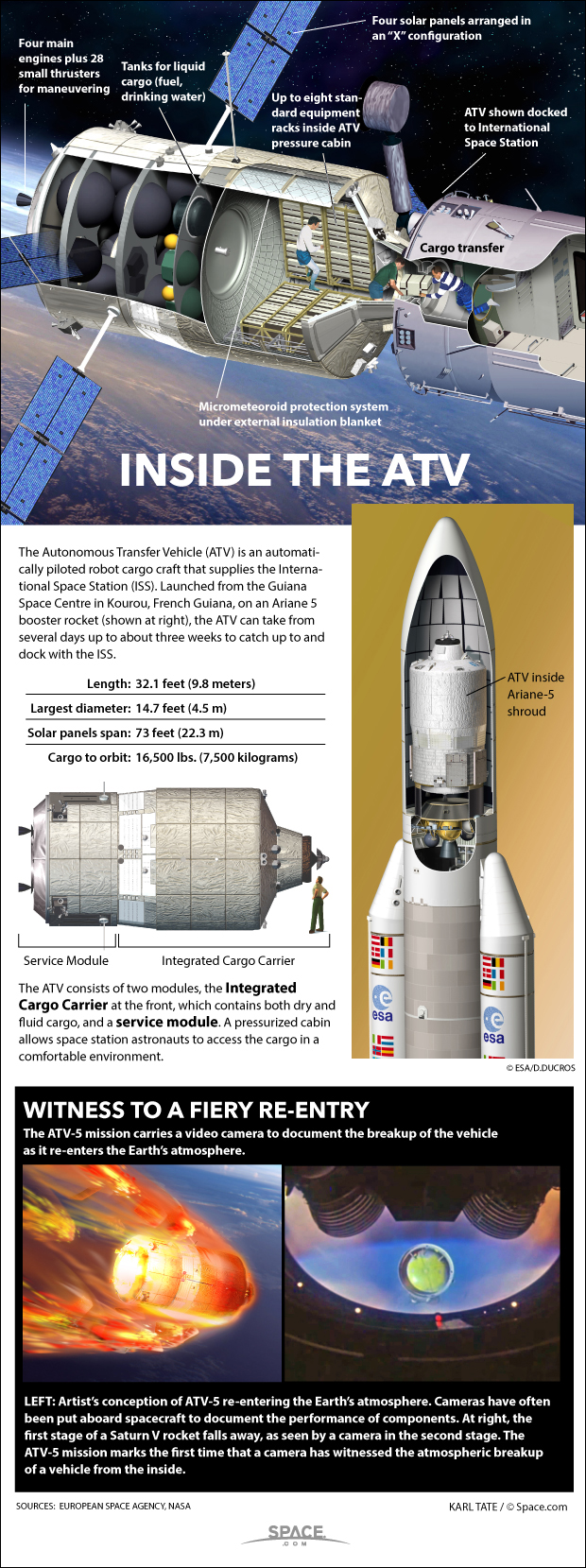Huge European Cargo Ship Launches Its Last Delivery Flight to Space Station

A European space cargo ship as large as a double-decker bus blasted off for the International Space Station on Tuesday, marking the final space voyage for the huge robotic spacecraft.
The European Space Agency's fifth Automated Transfer Vehicle launched into orbit atop an Ariane 5 rocket from French Guiana Tuesday evening (July 29) at 7:47 p.m. EDT (2347 GMT; 8:47 p.m. local time), kicking off the final mission for this line of unmanned spacecraft, which has been resupplying the space station since 2008.
ATV-5 will take its time getting to the orbiting lab, finally arriving on Aug. 12 with more than 7 tons of food, water, clothing, spare parts and scientific gear. The cargo vessel itself weighs 13 tons; the fully loaded ATV-5 is the heaviest payload ever lofted by an Ariane 5, European Space Agency (ESA) officials have said. [Europe's ATV-5 Space Cargo Ship Mission in Pictures]
ESA names each of its ATV vehicles after European scientists and thinkers. ATV-5 received the moniker "Georges Lemaitre," after the Belgian priest and astronomer considered the progenitor of the Big Bang theory of the universe's origin.
In keeping with its name, Georges Lemaitre is hauling some interesting scientific experiments to the International Space Station. One of them is ESA's Haptics-1 study, which will install a high-tech joystick on the station that astronauts will use to play simple video games.
The experiment should help researchers better understand how weightlessness affects human motor control, NASA officials said.
ATV-5 also carries ESA's "electromagnetic levitator," which will heat up metals and cool them quickly, revealing key insights about how atoms arrange and rearrange themselves during the process of melting and solidifying. (It's tough to study the basic physics involved here on Earth, since gravity plays a large and complicating role, ESA officials said.)
Breaking space news, the latest updates on rocket launches, skywatching events and more!
Several new rendezvous and docking sensors are also aboard Georges Lemaitre. The vehicle will test some of them during a close flyby of the space station on Aug. 8, while others will get a workout during ATV-5's final approach four days later, NASA officials said.
Even Georges Lemaitre's fiery death in Earth's atmosphere — which will likely come about six months after docking — should return some useful data. Infrared imagers aboard the cargo vessel will collect data during ATV-5's re-entry, helping engineers plan for the eventual de-orbit of the $100 billion space station. (NASA hopes to keep the orbiting complex operational through at least 2024.)
ATV-1 ("Jules Verne") launched toward the space station in March 2008, while ATV-2 ("Johannes Kepler") blasted off in February 2011. ATV-3 ("Edoardo Amaldi") followed in March 2012, and ATV-4 ("Albert Einstein") lifted off in June 2013.
The end of the ATV program does not mean robotic cargo deliveries to the orbiting lab will stop. Japan's H-II vehicle and Russia's Progress freighter remain operational, as do two vessels built by American aerospace firms: SpaceX's Dragon capsule and Orbital Sciences' Cygnus craft.
SpaceX holds a $1.6 billion deal with NASA to make 12 supply runs to the station with Dragon and has already completed three of those missions. Orbital Sciences, meanwhile, has flown one of eight expected cargo flights under a $1.9 billion NASA contract.
Follow Mike Wall on Twitter @michaeldwall and Google+. Follow us @Spacedotcom, Facebook or Google+. Originally published on Space.com.

Michael Wall is a Senior Space Writer with Space.com and joined the team in 2010. He primarily covers exoplanets, spaceflight and military space, but has been known to dabble in the space art beat. His book about the search for alien life, "Out There," was published on Nov. 13, 2018. Before becoming a science writer, Michael worked as a herpetologist and wildlife biologist. He has a Ph.D. in evolutionary biology from the University of Sydney, Australia, a bachelor's degree from the University of Arizona, and a graduate certificate in science writing from the University of California, Santa Cruz. To find out what his latest project is, you can follow Michael on Twitter.

